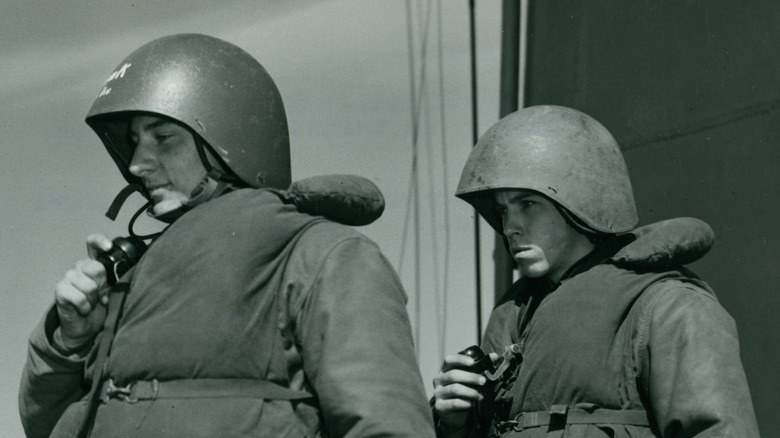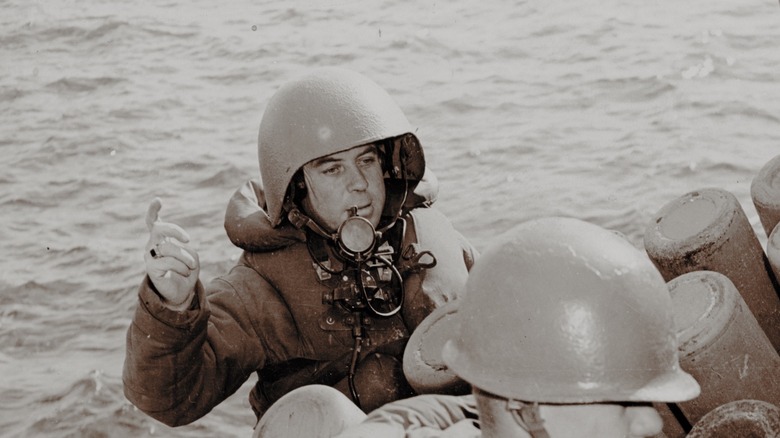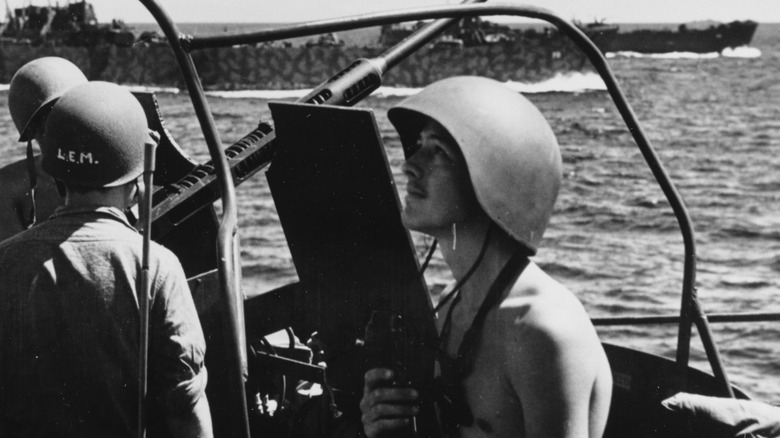Why Some US Navy Sailors Wore Helmets That Are Way Too Large For Their Heads
In the long history of human warfare, the shape and might of helmets have evolved dramatically. Their purpose, however, has remained the same — to protect a soldier's head from projectiles, ranging from arrows and stones to slowing down bullets. The first standard-issue American military helmet was the M1917, which was based on the British Mark 1 (Brodie) helmet. Later, the US developed an improved version that came to be known as the M1. It was heavily used during World War II and up until the Vietnam War, though it wasn't as iconic as the jets flying during that conflict in Asia.
Interestingly, there was a special version developed for personnel tasked with communication aboard vessels. The Mark 2 helmet, or the Mk 2, came to be known as the "Talker" helmet during the war. It was almost comically large and bulky, but designed for a purpose. During combat, communication between the officer on deck, damage control teams, and other units was crucial. This duty was assigned to communications personnel who wore bulky sound-powered telephone gear with large earcups and a microphone assembly linked to a central unit.
Unfortunately, the M1 helmet didn't offer enough space to fit the telephone earcups or any other critical gear, such as gas masks and binoculars. Therefore, the military was tasked with the creation of the Mk 2 helmet, which had an open design on the sides and a lifted cap on the front for unobstructed use of headsets and other head and face-mounted gear. The extended slope at the back also helped to block the sound from the surroundings.
What made it special?
In archival photographs and videos, the Mk 2 talker helmet is pretty easy to spot. The specialized helmet had a visor cut high so that personnel could comfortably use sky-searching binoculars and also protect their eyes from direct sunlight. Additionally, the curved cut on the sides left enough space so that the side vision (or peripheral viewing angle) was left open. The elongated rear portion of the helmet also protected the cervical vertebrae.
Owing to its bulky appearance, the talker helmet stood out from other military headgear of the era. There was space left out on each side for the ears, and the external shell was made of iron, with a textile-based lining inside and synthetic foam to act as cushioning. The cranial depth was around 327 millimeters, while the height was 220 millimeters. For comparison, the depth of the M1917 helmet worn by US soldiers during World War I was only about 279 millimeters.
A brief history of the talker helmet
The Mk 2 entered service with the Navy in 1942 and was designed and manufactured by the McCord Radiator Company. The outer shell was made of a special material called non-magnetic Hadfield manganese steel. Its design met a specific need: giving crew members enough space to wear bulky communication equipment while staying protected. Thanks to its wide profile, service members could use large sound-powered telephone headsets, gas masks, or binoculars without obstruction.
Beaver Edwards designed the helmet, and McCord filed a patent for it in 1942, eventually producing 400,000 units for the Navy. It was originally produced in the signature olive green color, but was quickly changed to a new haze grey shade. Officially referred to as Mk 2 Mod 0, this helmet remained in use well into the 1990s. Today, it's one of the most recognizable pieces of World War II naval history.


